ISSN ONLINE(2320-9801) PRINT (2320-9798)
ISSN ONLINE(2320-9801) PRINT (2320-9798)
| Prof. Jagdish Patel, Akshay Malik, Vrushali Thakare, Rahul Rajput Department of Electronics and Telecommunication, Sandip Institute of Technology and Research Centre, Nashik, India |
| Related article at Pubmed, Scholar Google |
Visit for more related articles at International Journal of Innovative Research in Computer and Communication Engineering
In the ancient times the war was fought using bow and arrows etc., this involved a large army of men that would fight and lay down their lives for their country. Some centuries later there was development in science and guns came into pictures . Today due to immense development in the area of technology it is possible to built more automated, unmanned, accurate, and more destructive forces in the form of weapons that human kind have never seen. The objective of this project is to minimize human casualties in terrorist attack such as 26/11. This is a project of war field robot with myraid applications at war field.
Keywords |
| Raspberry Pi, Android Application, Fire Fighting, Gun, Solar powered |
INTRODUCTION |
| Android phone is a boon to this era, and there are wondrous things that an Android phone can do. One of such wondrous things is controlling a robot at one’s ease. The sole purpose of this project is to minimize the human casualties in the terrorist attacks such as 26/11. The application for controlling the robot is developed using eclipse and it will control the movements of the robot at the same time will control all its features such as extinguishing the fire, the movement of camera, combating and stair climbing. Keeping in mind the war field scenario, this robot is powered by a solar panel and in order to draw maximum of its benefits, digital compass is used to drive the maximum solar light. |
RELATED WORK |
| As of now there are many projects related to war field robot which are controlled by android phone. In [1] the authors have made an android spy robot by mounting a camera on platform whose movement is governed by the stepper motor. Android phones have a huge potential as low cost robot controllers. Android programming is done in java which makes it very attractive to program because of familiarity to java. They have built in GPS compasses and cameras, Bluetooth and high end processors running at an average of 500Mhz.Hence the project establishes a bridge between the processor Android in the Smartphone and the microcontroller in the robot. The external inter face is totally controlled by means of the mobile phone. By being able to use the android phone as a controller for the robots, it form a cost efficient, powerful and extensible basis robot.They have used two smartphones to form a spy robot. The medium of communication between the phone and robot is the Bluetooth. In this project we have made raspberry pi as the Wi-Fi hotspot and the controlling of robot is done by an android app, hence reducing the need to have two android phones. The spy robot as the name suggests uses only camera. But in this project the simple applications are put altogether into one and controlled by an android phone. |
| Solar tracking for robot/vehicles is mostly done using fixed solar panels which is disadvantageous.In [2] the authors have mainly concentrated on the solar tracking feature and it involves a PIC microcontroller, digital compass, H-bridge drivers and a automatic solar tracker setup. The functioning of the solar tracking is independent of the robot movement. The unique feature of the proposed system is that instead of taking the earth as its reference, it takes the sun as a guiding source. Its active sensors constantly monitor the sunlight and rotate the panel towards the direction where the intensity of sunlight is maximum from morning to evening automatically, so that the panel grabs the solar energy to maximum extent possible throughout the day. When there is decrease in intensity of light, this system automatically changes its direction to get maximum intensity of light. The power generated from this process is then stored in a battery. The controlling device of the whole system is a PIC Microcontroller .The light dependent resistors do the job of sensing the change in the position of the sun which is dealt by the respective change in the solar panel’s position by switching on and off the geared motor. The voltage from solar panels will be displayed on LCD by interfacing solar panel to PIC microcontroller through a voltage measuring circuitry.In this project, keeping in mind the scenario at the war field, the robot is charged by the natural source of light and it involves the raspberry pi model B+. |
PROPOSED METHODOLOGY |
| Firstly an Android Application is developed in the Eclipse software using the Tabs. Creating tabs provide an easy way to navigate through the different parts of an app quickly. One tab consists the drop down to control the features of the robot such as combating and fire extinguishing. For the surveillance purpose the other tab is camera and the gestures to control the movement of the robot and the stair climbing. The following components will be required. |
| Tab Host: It is the main container for the tab buttons and tab content. |
| Tab Widget: It consists of the row of buttons, which may contain icons and/or text labels. |
| Frame Layout: It is the container for the tab content.In order to provide functionality to the tabs buttons, TabHost class is used which is available in the android:widget package. TabHost is implemented by navigating throughmultiple views within one activity. |
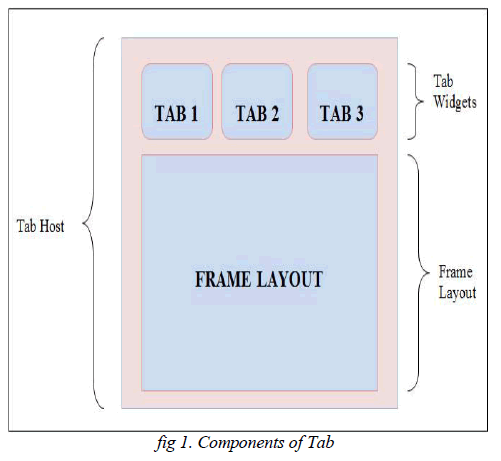 |
| To ensure the security, in order to allow access to only the authorized people a login Activity is created and then by using the Intent class the Login Activity is directed to the other Activity. In order to allow the multiple user logins and provide the flexibility of changing the username and password, the database can be used. The SQLite Database in android can be used. The screenshot of the login page is shown in the figure. If the username and password does not match then using the Toast a message is displayed on the screen. Inside the application, in order to get the video from the interfaced Raspberry pi camera, the IP of Raspberry pi is written in the android coding and the video surveillance is done. The commands are sent to the Raspberry Pi over WiFi. Raspberry Pi is made as hotspot by using the nano USB adapter, dongle and micro SD card. Using this hotspot the connection is established between the android application and the Raspberry Pi. |
| Secondly, using the Python programming the Raspberry Pi is programmed and the peripherals are interfaced. Intelligent Solar Tracking Systemis used to generate power from sunlight and it can be used by storing the generated power. This method of power generation is simple and is taken from natural resource. |
| The flow diagram of the project is shown below in the figure: |
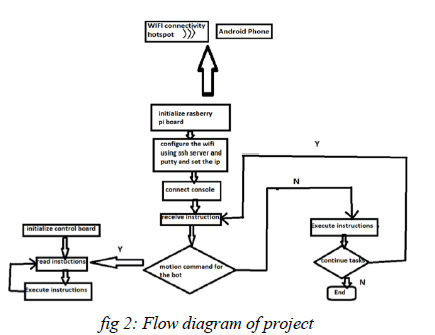 |
HARDWARE DESCRIPTION |
A. Raspberry Pi |
| Raspberry Pi is a credit card size mini computer, which can be used as microprocessor and microcontroller. This credit card size board is based on ARM 11 architecture. The Raspberry Pi B+ is shown in Fig 3. |
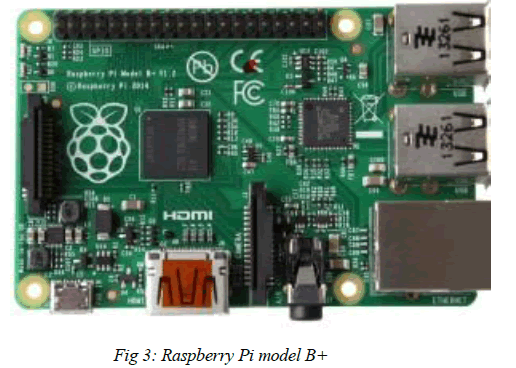 |
| The board shown in Fig 2 consists of 4 USB ports, HDMI port to interface it to the LCD to obtain the Raspberry pi window, 40 GPIO pins , audio video jack with DSP related fixes.Like any other computer, the Raspberry Pi also uses an operating system and thestock OS is a flavour of Linux called Raspbian. Linux is a great match for Raspberry Pibecause its free and open source. On one hand, it keeps the price of the platform low,and on the other, it makes it more hackable. And you are not limited to just Raspbian, as there are many different flavours, or distributions, of Linux that you can load ontothe Raspberry Pi. |
B. Sensors |
| A sensor is a device that detects events or changes in quantities and provides a corresponding output, generally as an electrical or optical signal. Magnetic metals arepretty straightforward when it comes to selecting a sensor, as any inductive proximityswitch will detect this type of metal. However, nonmagnetic metals can get a little more difficult, as you would need to take into account the decreased sensing rangefound with these targets. The factor by which the sensing range is reduced, based onthe target material, is called the reduction factor.Metal detectors are useful for finding metal enclosure hidden within the object or metal objects buried underground. Metaldetector here is used as bomb detector and for searching landmines. Inductively coupled coil is used to find out the metal present inside the ground. |
C. Solar Panel |
| A solar cell or photovoltaic cell is a device that converts solar energy into electricity by the photovoltaic effect. The collection of solar cells is called a solar panel or solar array. Solar panel is placed on top of the tracker board which absorbs the maximum sunlightwhich is used as supply to the motors or stored in the battery for future use. |
SIMULATION AND RESULTS |
| The simulation study include the following modules |
| 1. Robot |
| 2. Video surviliance on an android phone |
| 3. Controlling robot and the accessory on board using android phone |
| 4. Configuring Raspberry Pi to use it as a server to fetch live video espionage on an android phone. |
| First of all we configured the Raspberry Pi to work as a server using wifi dongle as shown in fig.4 |
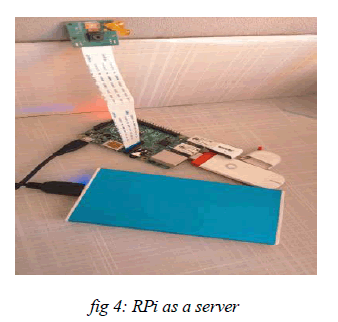 |
| The purpose of making a server is to establish connection between the android phone and the Raspberry Pi board to control the accessories on the robot. Insert the Wi-Fi dongle in Raspberry Pi and update all the packages required for configuring wifi dongle by using the command "Sudo apt-get update". Now upgrade all the newer versions of packages by using command "sudo apt-get upgrade". Check and make sure wifi dongle is installed correctlly, use command 'lsusb' which will list all the connected usb devices.After that use command 'lsmod' which shows all kernel modules that are currently loaded (eg, drivers). To connect to thr wireless network wifi network ssid and password is used for that network. Atlast the command "sudo wpa_cli state" is used so as to get the IP adress of Raspberry Pi. In the next step we created an android application using Eclipse IDE to control the movement of robot, and controlling other applictions of robot such as video surviliance, gun control, and system to complete the complex intelligent control tasks etc. Fig.5 shows some snaps of the application on an android phone. |
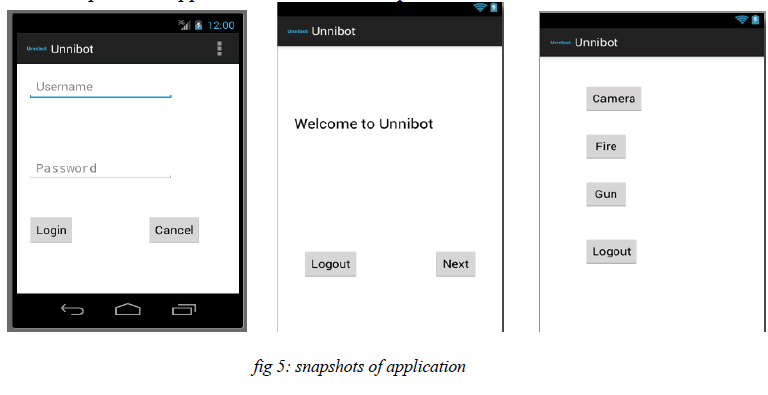 |
| RPi camera is usedwhich is compatible with the Raspberry Pi board and gives least delay for online transmission of video signal. |
CONCLUSION AND FUTURE WORK |
| The sole purpose of project is to reduce human casualties and to bolster the ammunition set of soldier. With the help of multiple features of Raspberry Pi robot was mademore compact and reliable. Also the connectivity of the robot and android phone wasestablished, which allowed the robot to be controlled by android phone and availed thefeatures of bot such as fire fighting, night vision camera and the rotation of robot in360 degree. |
References |
|